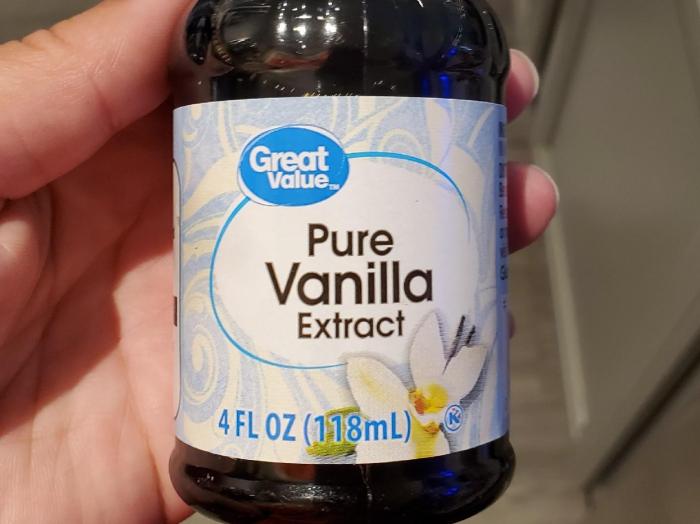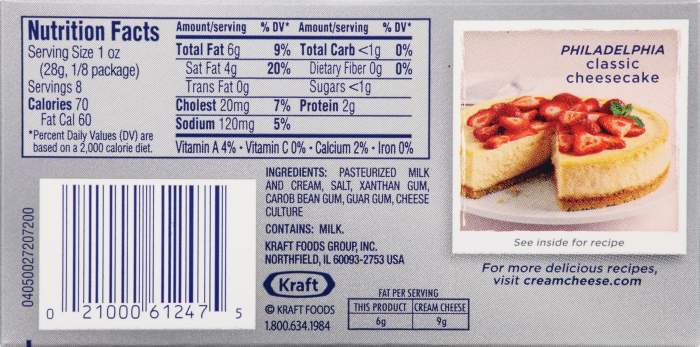Vanilla Extract Composition

Vanilla extract nutrition facts – Vanilla extract is a flavorful concentrate derived from vanilla beans, a prized spice known for its complex and aromatic profile. Its composition, however, varies significantly depending on whether it’s pure or imitation. Understanding these differences is crucial for discerning quality and appreciating the nuances of this popular ingredient.
Primary Components of Vanilla Extract
Pure vanilla extract’s primary components are vanilla beans, water, and alcohol. The beans themselves are comprised of a multitude of chemical compounds, primarily vanillin, which contributes the characteristic vanilla flavor, along with other aromatic compounds that add complexity and depth. The water acts as a solvent, and the alcohol (typically ethanol) serves as both a solvent and a preservative, extracting the flavor compounds from the beans and preventing microbial growth.
The precise ratio of these components influences the final flavor and strength of the extract.
Pure Vanilla Extract versus Imitation Vanilla Extract
The key difference between pure and imitation vanilla extract lies in the source of vanillin. Pure vanilla extract is made exclusively from vanilla beans, undergoing a meticulous process of extraction to capture the full spectrum of flavors. Imitation vanilla extract, on the other hand, utilizes synthetic vanillin, often derived from lignin, a byproduct of the paper-making process, or other synthetic sources.
While synthetic vanillin can mimic the flavor of natural vanillin to some degree, it often lacks the complexity and nuanced notes found in pure vanilla extract. Other ingredients, such as colorings and flavor enhancers, may also be added to imitation vanilla extract to further enhance its resemblance to the real thing.
The Role of Alcohol in Vanilla Extract
Alcohol plays a vital role in the production and preservation of vanilla extract. It acts as a solvent, efficiently extracting the flavorful compounds from the vanilla beans. The alcohol content also acts as a preservative, inhibiting the growth of bacteria and mold, thus ensuring the extract’s shelf life and preventing spoilage. The alcohol percentage typically ranges from 35% to 45% in pure vanilla extracts, contributing significantly to the extract’s overall character and longevity.
Nutritional Comparison of Pure and Imitation Vanilla Extracts
| Ingredient | Pure Vanilla Extract | Imitation Vanilla Extract | Difference |
|---|---|---|---|
| Vanillin (mg/ml) | Variable, depending on bean quality and extraction method; generally lower | Variable, depending on formulation; generally higher | Imitation often contains significantly more vanillin, though not necessarily indicative of superior flavor. |
| Alcohol (Ethanol) (%) | 35-45% | May contain alcohol, or be alcohol-free | Pure vanilla extract almost always contains a significant amount of alcohol as a solvent and preservative; imitation may or may not. |
| Calories | Approximately 20-25 calories per teaspoon (due to alcohol content) | Approximately 0-10 calories per teaspoon (depending on formulation) | Pure vanilla extract has more calories due to alcohol content. |
| Other Ingredients | Water | May contain artificial colors, flavors, and preservatives | Imitation extracts contain a variety of additives that are absent in pure vanilla extract. |
Nutritional Information of Vanilla Extract

Pure vanilla extract, a prized culinary ingredient, is often considered for its flavor rather than its nutritional content. While it contributes minimal calories and nutrients to a recipe, understanding its nutritional profile can be helpful for those meticulously tracking their intake. This section details the macronutrients, calorie count, potential vitamins and minerals, and allergens associated with pure vanilla extract.
Macronutrient Composition of Vanilla Extract
Vanilla extract primarily consists of water and alcohol, with a small amount of vanilla bean extract. As such, its macronutrient content is negligible. A typical serving size (approximately 1 teaspoon) contains virtually no carbohydrates, fats, or proteins. The values are so insignificant that they are generally considered zero on nutritional labels. This is because the primary components—alcohol and water—do not contribute to these macronutrients.
Any trace amounts present are likely from the vanilla bean itself, which contributes minimal amounts of these macronutrients in comparison to other food sources.
Calorie Count of Vanilla Extract
Given the extremely low amounts of macronutrients, the calorie count per serving of pure vanilla extract is also negligible. A one-teaspoon serving will contribute less than 5 calories. This makes it a virtually calorie-free ingredient in most culinary applications.
Vitamins and Minerals in Vanilla Extract
Vanilla extract does not provide significant amounts of vitamins or minerals. While vanilla beans themselves contain trace amounts of certain nutrients, the extraction process results in a final product with minimal nutritional value in this regard. The focus remains primarily on its flavor profile rather than its contribution to daily vitamin or mineral requirements.
Vanilla extract, a common baking ingredient, boasts minimal calories and carbohydrates. Its nutritional profile contrasts sharply with that of other beverages, such as energy drinks; for instance, you can find detailed information regarding monster energy nutrition facts online to compare. Returning to vanilla extract, its primary nutritional contribution lies in its intense flavor rather than significant caloric or macronutrient content.
Potential Allergens in Vanilla Extract
The main potential allergen in vanilla extract is vanilla itself. Individuals with a known allergy to vanilla should avoid its consumption. While rare, allergic reactions can occur, ranging from mild skin irritation to more severe symptoms. It is important to note that some commercial vanilla extracts may contain other ingredients, such as preservatives or flavor enhancers, which could also pose allergic risks.
Always check the ingredient list if you have concerns about allergies. Furthermore, cross-contamination during processing is a possibility, so those with severe allergies should exercise caution.
Health Implications and Considerations: Vanilla Extract Nutrition Facts
Vanilla extract, while generally considered safe for consumption in moderate amounts, presents some health implications due to its alcohol content and potential interactions with certain medications or health conditions. Understanding these factors is crucial for safe and responsible use.Vanilla extract’s potential health benefits are primarily linked to its antioxidant properties derived from vanillin, the primary flavor compound. However, these benefits are generally associated with the consumption of vanilla beans or extracts in relatively small quantities, as part of a balanced diet, and not as a standalone health supplement.
The significant alcohol content in many vanilla extracts needs careful consideration.
Alcohol Content and Consumption
Many vanilla extracts are made with a high percentage of alcohol, typically ranging from 35% to 70%. Excessive consumption of vanilla extract, primarily due to its alcohol content, can lead to negative health consequences such as intoxication, liver damage, and other alcohol-related problems. It’s crucial to remember that the alcohol content contributes to the overall caloric intake and should be factored into daily alcohol consumption limits.
Individuals with a history of alcohol abuse or those who are pregnant or breastfeeding should exercise particular caution and ideally consult with a healthcare professional before using vanilla extract. Moreover, the use of vanilla extract as a flavoring agent in food and beverages does not negate the contribution of alcohol to total daily intake. For example, a recipe that calls for a significant amount of vanilla extract, combined with other alcoholic ingredients, could easily exceed recommended daily limits for alcohol consumption.
Potential Interactions with Medications and Health Conditions
Vanilla extract itself is unlikely to directly interact with most medications. However, the alcohol content can interact negatively with certain medications, particularly those metabolized by the liver. Individuals taking medications that are sensitive to alcohol should exercise caution and consult their physician or pharmacist before incorporating vanilla extract into their diet. For example, individuals on medication for diabetes or those with liver disease might need to be mindful of the alcohol content in vanilla extract.
Moreover, individuals with existing conditions such as alcohol intolerance or alcohol addiction should strictly avoid excessive consumption of vanilla extract.
Safe Usage and Storage of Vanilla Extract
Safe usage of vanilla extract involves mindful consumption, considering the alcohol content and potential interactions. Use it sparingly as a flavoring agent, avoiding excessive ingestion. Store vanilla extract in a cool, dark place, away from direct sunlight and heat. Proper storage helps maintain its flavor and quality and prevents the alcohol from evaporating too quickly. Furthermore, ensure the container is tightly sealed to prevent the loss of aroma and alcohol content.
Expired vanilla extract may lose its potency and aroma, and its use should be avoided. Always check the expiration date on the bottle before use.
Visual Representation of Nutritional Data

Visual representations are crucial for effectively communicating the nutritional information of vanilla extract. Charts and graphs can simplify complex data, making it easily understandable for consumers. The following descriptions detail how visual aids can clarify the macronutrient composition and calorie comparison of different vanilla extract types.
Macronutrient Composition of Pure Vanilla Extract in a Bar Graph
A horizontal bar graph would effectively illustrate the macronutrient composition of pure vanilla extract. The x-axis would represent the macronutrients: carbohydrates, protein, and fat. The y-axis would display the amount of each macronutrient, perhaps expressed in grams per 100ml or per teaspoon. Each macronutrient would be represented by a differently colored bar, with a clear legend indicating which color corresponds to which macronutrient.
The lengths of the bars would be proportional to the quantity of each macronutrient, visually highlighting the dominant component (likely carbohydrates, given the sugar content of vanilla extract). The graph’s title would be “Macronutrient Composition of Pure Vanilla Extract,” and clear labels would be provided for all axes and bars. For added clarity, percentage values could be included above each bar, indicating the relative proportion of each macronutrient.
Calorie Comparison of Pure vs. Imitation Vanilla Extract in a Column Chart, Vanilla extract nutrition facts
A simple column chart could clearly compare the calorie content of pure and imitation vanilla extracts. The x-axis would categorize the vanilla extract types: “Pure Vanilla Extract” and “Imitation Vanilla Extract.” The y-axis would represent the calorie count, perhaps per teaspoon or per milliliter. Two columns, one for each type of vanilla extract, would be displayed, with their heights representing their respective calorie counts.
Different colors would distinguish the columns, and a clear legend would identify each. The chart’s title would be “Calorie Comparison: Pure vs. Imitation Vanilla Extract.” Data labels would appear above each column, showing the exact calorie count. This visual comparison would immediately highlight any significant differences in calorie content between the two types. For instance, if pure vanilla extract contains significantly fewer calories, the column representing pure vanilla extract would be noticeably shorter than the column representing imitation vanilla extract.
FAQs
Is vanilla extract gluten-free?
Yes, pure vanilla extract is naturally gluten-free. However, always check the label to ensure no cross-contamination has occurred during processing.
Can I use vanilla extract if I’m on a low-carb diet?
Vanilla extract is very low in carbohydrates, making it suitable for most low-carb diets. However, be mindful of the alcohol content if you are strictly limiting alcohol intake.
Does vanilla extract expire?
Yes, vanilla extract has a shelf life. Pure vanilla extract can last for several years if stored properly in a cool, dark place. Check the expiration date on the bottle.
Is vanilla extract suitable for vegans?
Pure vanilla extract is generally considered vegan, provided it doesn’t contain any animal-derived ingredients or additives. Always check the label for confirmation.
Can I substitute imitation vanilla extract for pure vanilla extract in all recipes?
While imitation vanilla extract can be used as a substitute, the flavor profile differs significantly. Pure vanilla extract generally offers a richer, more complex flavor.




